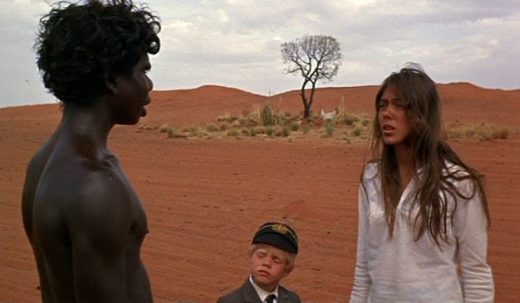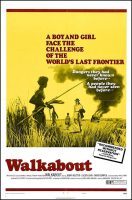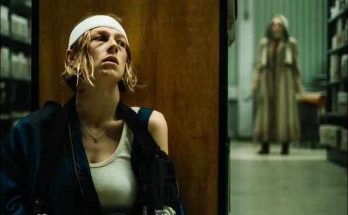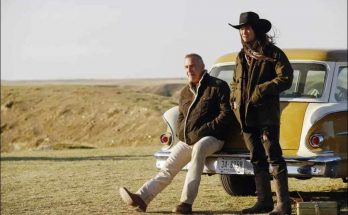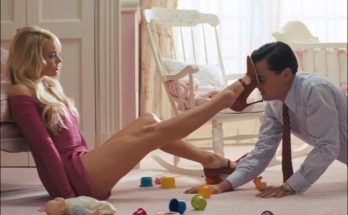Walkabout movie review. Excluding British director Nicolas Roeg’s collaboration with Donald Cammell in the 1970 film Performance, Walkabout is Roeg’s first individual directorial experience. Walkabout literally means wandering around, but it was released in our cinemas under the name Endless Desert, probably as a marketing strategy. In the prologue of the film, information is given that Aboriginal boys who are 16 years old are sent to the desert to prove themselves and directly experience the struggle for survival, and that the film is about this.
At the opening of the film, we are guests at the house of a British family living in Australia. This family gives the appearance of a rich family because of what they eat, live and wear. Before they had the opportunity to get to know the characters in detail, the two children and the father, except their mother, went for a walk or picnic in the desert.
After an incident that we don’t know whether it was a sudden nervous breakdown or something else, two siblings, an 8-9 year old boy and the other a high school girl, are left alone in the middle of the desert. They do not have any knowledge, or rather experience, about the desert, and we can assume that even their clothes may not have been contaminated before, which is an exaggeration due to their status.
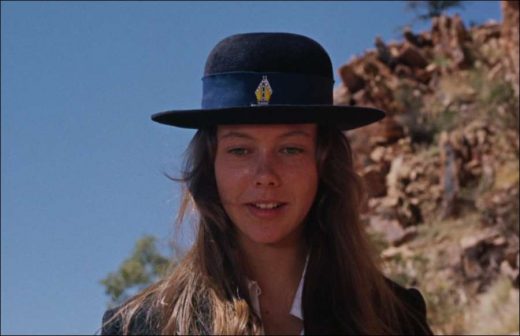
These two brothers encounter an aboriginal person after spending a difficult and difficult time in the desert. He fits the description of the 16-year-old male aboriginal mentioned in the film’s prologue. It is obvious from his actions that he knows the desert and how to survive in it. From this moment on, the camera begins to look at the desert not from the eyes of the bourgeois, but from the eyes of the aboriginal people living in the desert.
The situation the brothers are in pushes them to establish a dialogue with the aboriginal youth, whom they would normally not even greet when they meet at any time. Especially the girl’s dialogue stems from the fact that she secretly sees the aboriginal young man as the last ticket out of the desert.
The younger brother, on the other hand, positions the aboriginal as a playmate in his mind. While the boy establishes a more sincere conversation, the girl establishes a relationship based more on interest. He even prefers to have his brother ask the question he is going to ask in a scene, using a language similar to sign language. This situation is related to the fact that he does not see his communication with her as long-lasting.
Even though Roeg’s use of cuts, which he frequently uses from the beginning of the film, is risky, his attitude of knowing what he is doing where and what he is doing causes the cuts that may look patchy to add a very good integrity to the film. Although it is his first individual directorial experience, it does not even come close to the question of whether it can turn into an experimental product in the hands of the director. It is worth considering that this situation is directly related to Nicolas Roeg’s nearly 20 years of experience in other professions, behind the camera for a long time before starting his directorial career.
When Nicolas Roeg met Jenny Agutter, who played the lead role, Agutter was a student at a ballet boarding school. He went to Roeg and Roeg’s wife in a school uniform similar to the one he wore in the movie. After that meeting, Roeg wanted this outfit to be in the movie. The lead role played by Jenny Agutter is used by the director to trigger sexual tension between the roles, although it is not obvious in Walkabout. We can understand this from the director’s cuts I mentioned above.
In these cuts, Agutter’s body lines are generally in the frame. Before the nervous breakdown experienced by the father mentioned at the beginning of the article, we catch a moment in one scene where the father glances at his daughter’s body lines. This situation makes the audience question whether the father has a healthy mind or not. After all, we are exposed to that unexpected nervous breakdown.
Hunting animals is at the forefront in Walkabout, which focuses on the desert and therefore wildlife. Although I have question marks in my mind about the reality of the hunting scenes, considering the conditions of the time, the feeling that most of the scenes could be real is a bit annoying.
The slaughtering that Roeg frequently uses occurs especially during the dismemberment of hunted animals. Roeg overlaps the actions of the aboriginal with the actions of the butcher in modern life. We understand that in such scenes, the director’s aim is not to show the differences between primitive life and modern life, which dominate the entire film, but on the contrary, to show how similar they are to each other in form.
Walkabout; He is not very interested in the starting or ending point of the journey. Neither the beginning nor the end of the journey is based on strong reasons. He says the important thing is the journey. The ultimate goal of any journey is to partially change what started out. Especially in this type of desert journey, a radical change is expected to provide a better service to the film. But Roeg does not offer any changes to the characters here. It creates the feeling of a faint memory.
Walkabout (1971)
Directed by: Nicolas Roeg
Starring: Jenny Agutter, David Gulpilil, Luc Roeg, John Meillon, Robert McDarra, Peter Carver, John Illingsworth, Hilary Bamberger, Barry Donnelly, Noeline Brown, Carlo Manchini
Screenplay by: Edward Bond
Production Design by: Brian Eatwell
Cinematography by: Nicolas Roeg
Film Editing by: Antony Gibbs, Alan Pattillo
Art Direction by: Terry Gough
Makeup Department: Linda Richmond
Music by: John Barry
MPAA Rating: None.
Distributed by: 20th Century Fox
Release Date: July 1, 1971
Visits: 113
